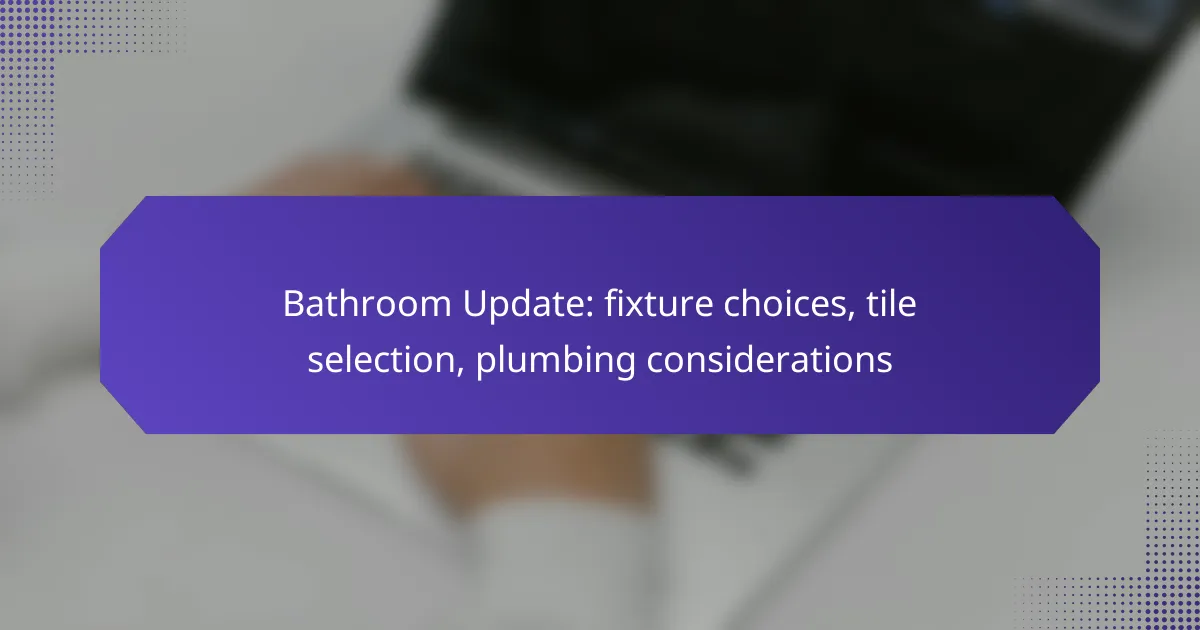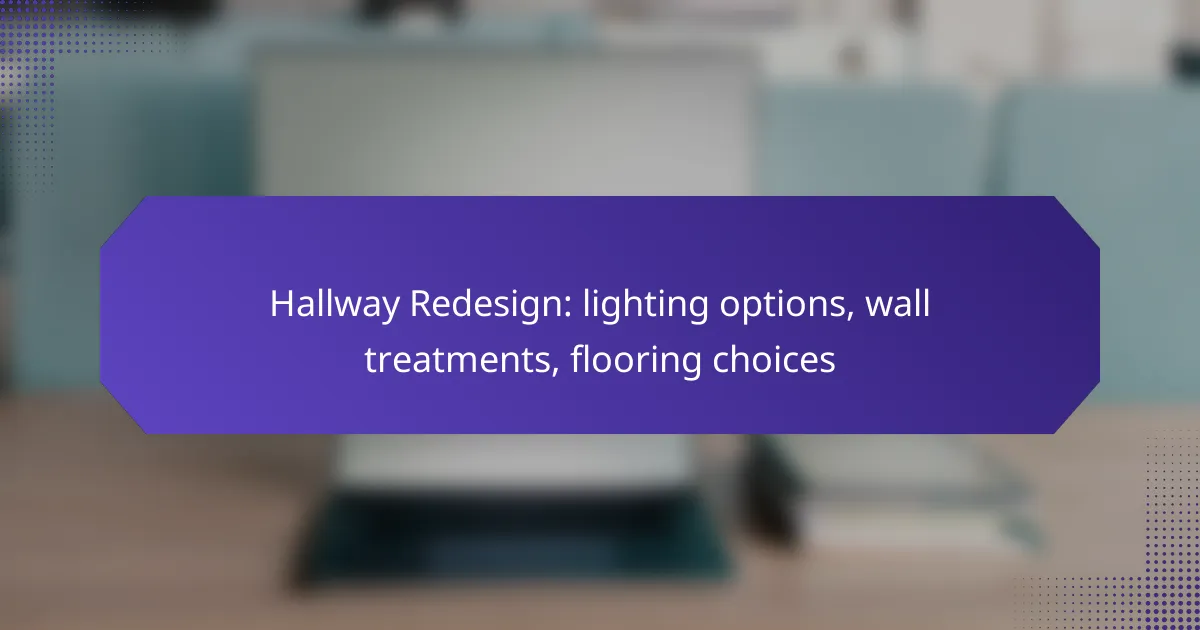Updating your bathroom involves careful selection of fixtures, tiles, and plumbing to create a space that is both stylish and functional. When choosing fixtures, prioritize water-saving features and compatibility with existing plumbing to enhance efficiency. Additionally, consider plumbing aspects such as pipe materials and drainage layout to ensure a seamless renovation process.

What are the best bathroom fixtures for modern homes?
The best bathroom fixtures for modern homes combine functionality, style, and efficiency. Key considerations include water-saving features, ease of installation, and compatibility with existing plumbing.
Faucets from Moen
Moen faucets are known for their innovative designs and reliable performance. They offer a variety of styles, from sleek modern looks to classic designs, ensuring a fit for any bathroom aesthetic.
When selecting a Moen faucet, consider features like touchless activation and water-saving technology, which can reduce water usage by up to 30%. Ensure compatibility with your sink and plumbing setup to avoid installation issues.
Toilets from Kohler
Kohler toilets are recognized for their efficiency and comfort. Many models feature dual-flush systems that allow users to choose between a full or partial flush, significantly conserving water.
Look for models with a WaterSense label, which indicates they use less than 1.28 gallons per flush. Installation typically requires standard plumbing knowledge, but professional help may be needed for complex setups.
Showerheads from Delta
Delta showerheads offer a range of options, including handheld, rain shower, and multi-function designs. Their H2Okinetic technology creates a unique water pattern that feels like more water while using less.
When choosing a Delta showerhead, consider the flow rate, which should ideally be 2.0 GPM or lower for water efficiency. Ensure that your existing plumbing can support the chosen model for optimal performance.
Vanities from IKEA
IKEA vanities are popular for their modern designs and affordability. They come in various sizes and finishes, allowing for customization to fit different bathroom layouts.
Consider the storage options and countertop materials when selecting a vanity. IKEA’s modular systems can be easily adapted, but ensure you have the correct measurements to avoid fitting issues during installation.

How to choose tiles for bathroom renovations?
Choosing tiles for bathroom renovations involves considering durability, aesthetics, and maintenance. The right tiles can enhance the space’s functionality while reflecting your personal style.
Porcelain tiles for durability
Porcelain tiles are an excellent choice for bathrooms due to their high durability and water resistance. They are denser than ceramic tiles, making them less prone to cracking and chipping. When selecting porcelain tiles, look for options with a PEI rating of 4 or 5 for optimal wear resistance.
Additionally, porcelain tiles come in various styles and finishes, allowing you to achieve the desired look without sacrificing performance. They are also relatively easy to clean, making them a practical option for high-moisture areas.
Subway tiles for a classic look
Subway tiles offer a timeless aesthetic that can fit various bathroom styles, from traditional to modern. Typically measuring 3×6 inches, these rectangular tiles can be arranged in different patterns, such as herringbone or stacked, to create visual interest.
When using subway tiles, consider grout color carefully, as it can significantly impact the overall appearance. White grout provides a clean look, while darker shades can add depth and contrast. Ensure to seal the grout properly to prevent moisture absorption and staining.
Natural stone tiles for luxury
Natural stone tiles, such as marble or granite, add a touch of luxury to any bathroom. These tiles are unique, with each piece showcasing distinct veining and color variations. However, they require more maintenance than porcelain or ceramic tiles, as they are more porous and susceptible to staining.
When choosing natural stone tiles, consider applying a sealant to protect against moisture and stains. Additionally, be aware of the weight of natural stone; ensure your subfloor can support it, especially in older homes. Regular cleaning with pH-neutral products will help maintain their beauty over time.

What plumbing considerations should be made during a bathroom update?
During a bathroom update, key plumbing considerations include pipe material selection, water pressure requirements, and drainage layout planning. Addressing these factors ensures a functional and efficient bathroom that meets both aesthetic and practical needs.
Pipe material selection
Choosing the right pipe material is crucial for durability and performance. Common options include PVC, PEX, and copper, each with its own advantages. For example, PEX is flexible and resistant to corrosion, making it ideal for retrofitting, while copper is known for its longevity and resistance to bacteria.
Consider local building codes when selecting materials, as some areas may have specific regulations regarding plumbing materials. Additionally, factor in the cost differences; PVC is generally the most affordable, while copper tends to be more expensive but offers long-term benefits.
Water pressure requirements
Water pressure is vital for the proper functioning of fixtures like showers and faucets. Most residential systems operate best with a pressure range of 40 to 60 psi. If your pressure is too low, you may experience weak water flow, while excessively high pressure can lead to leaks and damage.
Testing your water pressure can help identify any issues before starting your bathroom update. If adjustments are needed, consider installing a pressure regulator to maintain optimal levels and protect your plumbing system.
Drainage layout planning
Effective drainage layout is essential to prevent clogs and ensure proper wastewater removal. When planning your bathroom update, consider the slope of the drainage pipes; a minimum slope of 1/4 inch per foot is generally recommended for optimal flow.
Additionally, think about the placement of fixtures in relation to existing drain lines. Relocating fixtures can complicate drainage, so it’s often best to keep them close to existing plumbing. Consulting with a plumber can help you design a layout that meets both functional and aesthetic goals.

What are the costs associated with bathroom fixture updates?
The costs for updating bathroom fixtures can vary widely based on the type and quality of the fixtures chosen. Homeowners should budget for faucets, tiles, and plumbing work, as these elements can significantly impact the overall expense of a bathroom renovation.
Average costs for faucets
Faucet prices typically range from around $50 to several hundred dollars, depending on the brand, style, and features. Basic models may cost less, while high-end faucets with advanced technology or designer aesthetics can be much pricier.
When selecting a faucet, consider the finish and functionality, as these factors can influence both the cost and durability. Installation costs may add an additional $100 to $300 if professional help is needed.
Estimated expenses for tiles
Tile costs can vary significantly, with prices ranging from approximately $1 to $20 per square foot. Ceramic and porcelain tiles are often more affordable, while natural stone options tend to be on the higher end of the scale.
In addition to the tile itself, factor in installation costs, which can range from $5 to $15 per square foot. Choosing larger tiles can reduce installation time and labor costs, making them a practical option for budget-conscious homeowners.
Budgeting for plumbing work
Plumbing work can be one of the more expensive aspects of a bathroom update, with costs typically ranging from $45 to $200 per hour for labor. The total expense will depend on the complexity of the plumbing changes required, such as relocating pipes or installing new fixtures.
To avoid unexpected costs, obtain multiple quotes from licensed plumbers and ensure they are familiar with local building codes. Planning ahead can help you stay within budget while ensuring quality work is completed.

What are the latest trends in bathroom design?
The latest trends in bathroom design emphasize functionality, sustainability, and smart technology. Homeowners are increasingly opting for fixtures and materials that enhance efficiency while providing a modern aesthetic.
Smart fixtures for efficiency
Smart fixtures are becoming a staple in contemporary bathrooms, offering enhanced efficiency and convenience. These include touchless faucets, smart showers, and toilets that conserve water and energy while providing user-friendly features.
When choosing smart fixtures, consider the integration with home automation systems. Many products can be controlled via smartphone apps, allowing for personalized settings and remote operation. Look for fixtures that meet local water efficiency standards, such as those certified by WaterSense in the United States.
Common pitfalls include overcomplicating the installation process or neglecting compatibility with existing plumbing. Ensure that the smart fixtures you select are easy to install and maintain, and always check for warranty options to protect your investment.










